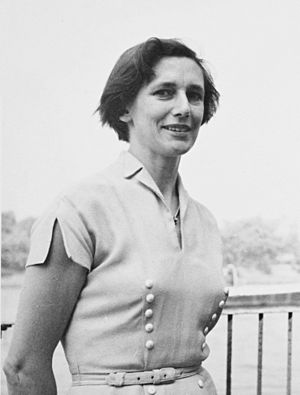Ruth Sanger facts for kids
Quick facts for kids
Ruth Sanger
|
|
|---|---|

Ruth Sanger c. 1950
|
|
| Born |
Ruth Ann Sanger
6 June 1918 Southport, Queensland, Australia
|
| Died | 4 June 2001 (aged 82) Putney, London, England
|
| Alma mater | Sydney University University of London |
| Known for | Haematology, serology, Fellow of the Royal Society |
| Spouse(s) | Robert Russell Race (1956-1984) |
| Awards |
|
Ruth Ann Sanger (born June 6, 1918 – died June 4, 2001) was an Australian scientist. She studied how our bodies fight off diseases (immunogenetics). She also worked with blood (haematology) and blood tests (serology).
Ruth Sanger was famous for her research on human blood cells. She helped understand different blood groups. She also mapped the X chromosome, which is one of the chromosomes that determines if someone is male or female. From 1973 to 1983, she led the Blood Group Unit at the Medical Research Council.
She worked closely with another scientist, Robert Russell Race, starting in the 1940s. They got married in 1956. Together, they wrote many important papers. They also wrote six versions of a famous book called Blood Groups in Man. This book helped make blood transfusions much safer for everyone. People often just called the book "Race and Sanger."
Contents
Ruth Sanger's Early Life and School
Ruth Sanger was born in Southport, Queensland, Australia. She grew up with four brothers and sisters. Her father, Rev. Hubert Sanger, became the headmaster of a school in New South Wales. Ruth was also a cousin of Frederick Sanger, who was a biochemist and won the Nobel Prize twice!
Ruth went to several schools in New South Wales. These included Harleyville Ladies College, New England Girls School, and Abbotsleigh Wahrounga.
She then went to Sydney University and earned a Bachelor of Science degree in 1940. Later, she earned her PhD from the University of London in 1948.
Ruth Sanger's Scientific Career
From 1940 to 1946, Ruth worked with blood at the Red Cross Blood Transfusion Service in Sydney, Australia. In 1946, she moved to England. There, she joined R.R. Race at the Medical Research Council's Blood Group Unit.
While working there, she earned her doctorate degree in 1948. Her research focused on the many different blood group systems. After getting her degree, she went back to Australia for a short time. But in 1950, she moved back to the United Kingdom for good. She continued her important work at the Medical Research Council until 1973.
The first version of her famous book, Blood Groups in Man, came out in 1950. It was based on the detailed studies she did for her PhD.
In 1973, Ruth Sanger took over from R.R. Race as the Director of the Medical Research Council's Blood Group Unit. This unit was located at the Lister Institute of Preventive Medicine in London. She retired from this role in 1983.
Awards and Special Recognitions
Ruth Sanger received many important awards for her amazing work:
- Karl Landsteiner Memorial Award, USA (1957), which she shared with R. R. Race.
- Philip Levine Award, USA (1970), also shared with R. R. Race.
- She became a Fellow of the Royal Society (FRS) in 1972. This is a very high honor for scientists.
- Gairdner Foundation International Award (1972, Canada), shared with R. R. Race.
- Oliver Memorial Award from the British Red Cross (1973).
- She received an honorary Doctor of Medicine degree from Helsinki University in 1990. This means the university recognized her great achievements.
When she was nominated for the Royal Society, they said she was an "Immunogeneticist" who worked on "human red cell antigens" and "genetic mapping of the human X chromosome." This means she was recognized for her deep understanding of blood types and how genes are arranged on the X chromosome.
Ruth Sanger's Personal Life
Ruth Sanger married Robert Race on April 6, 1956. This was after Race's first wife had passed away.
Her Passing
Ruth Sanger passed away in Putney in 2001. She did not have any children.
Images for kids


